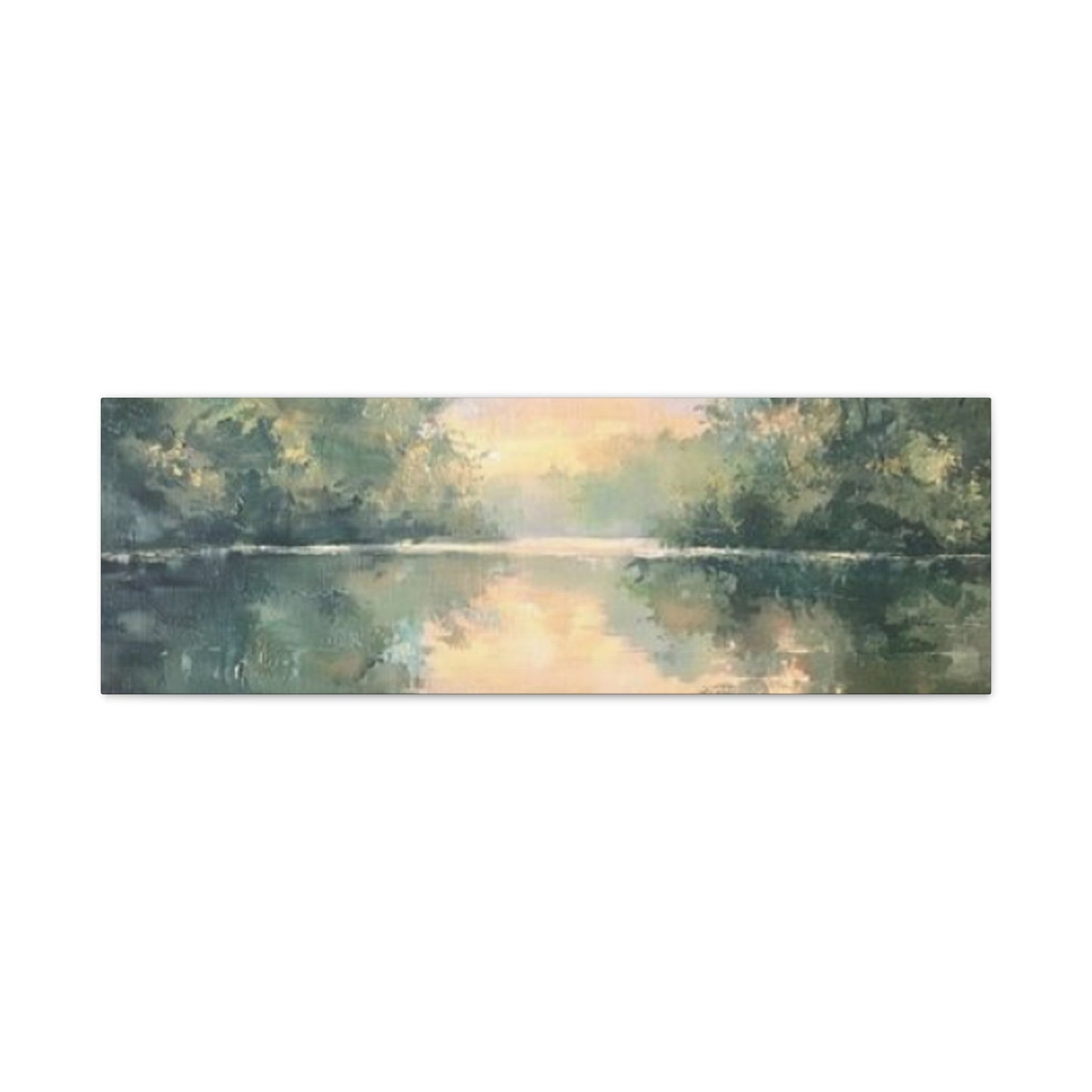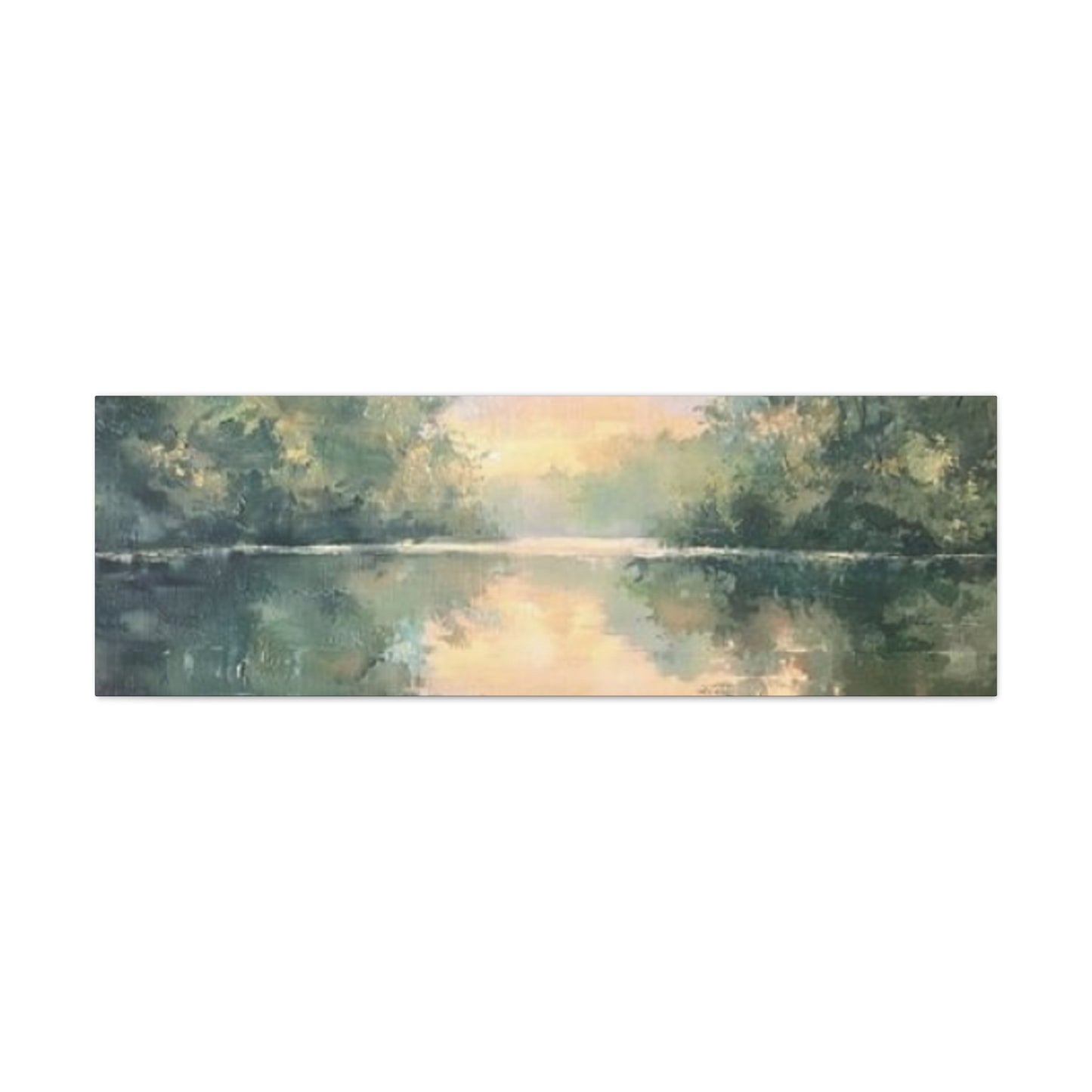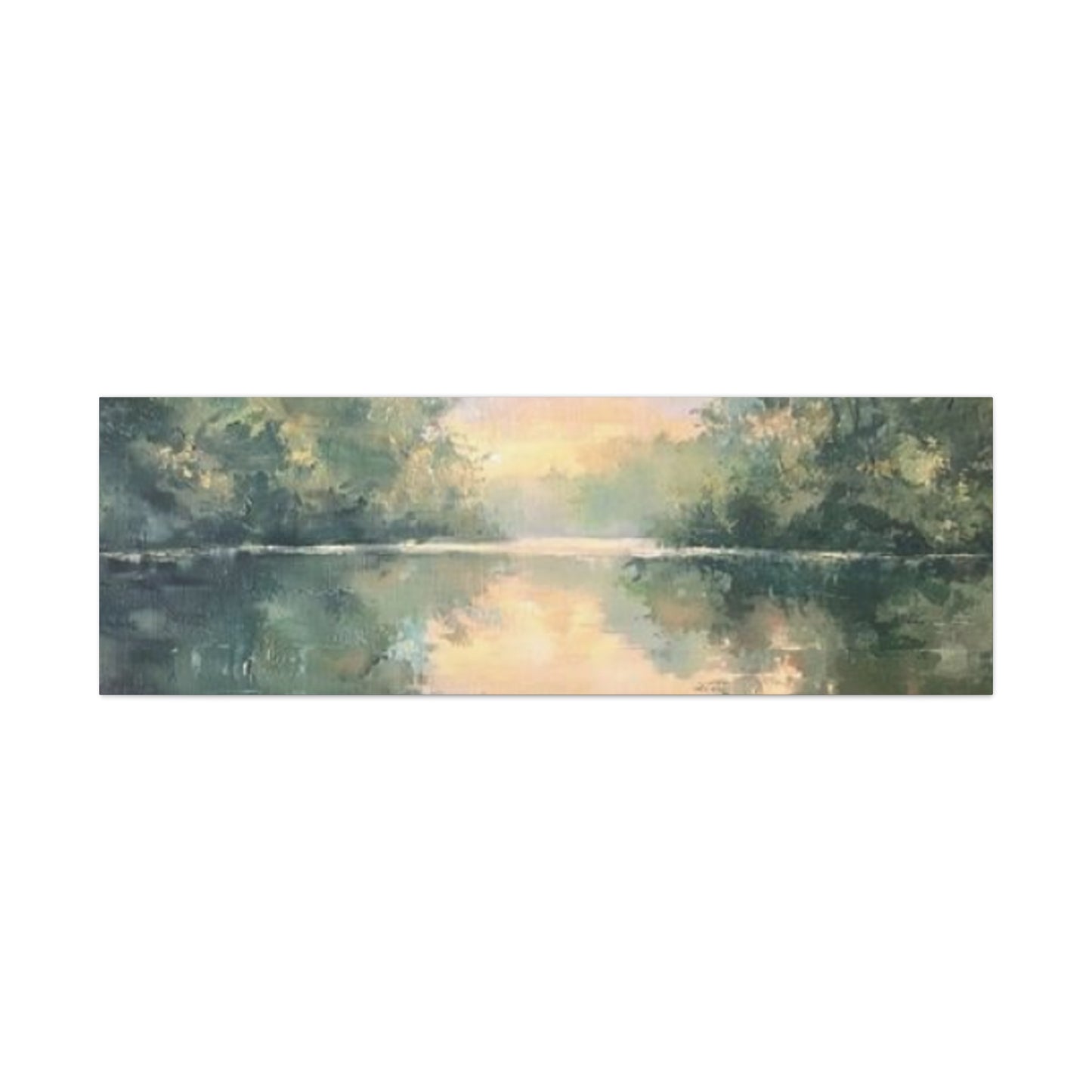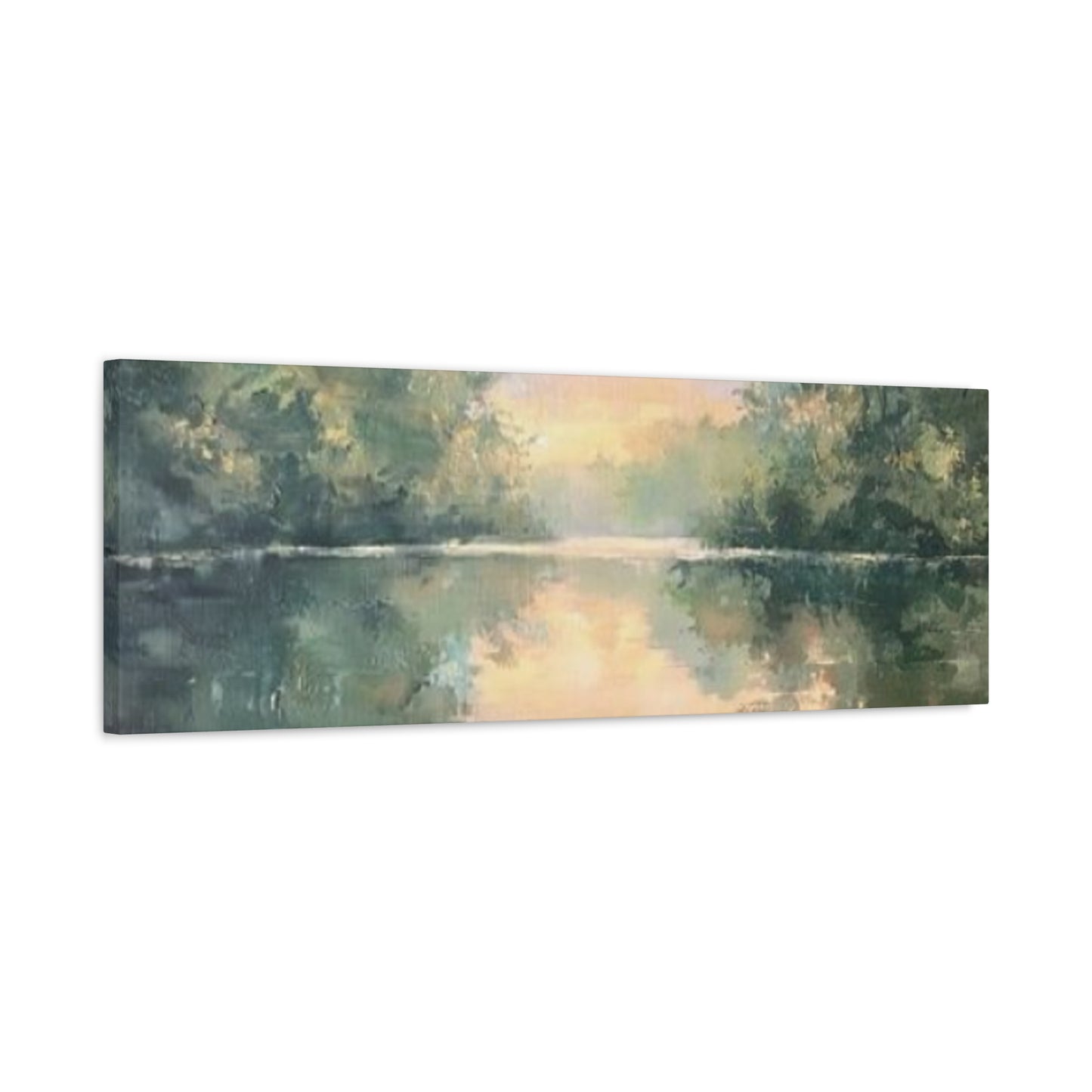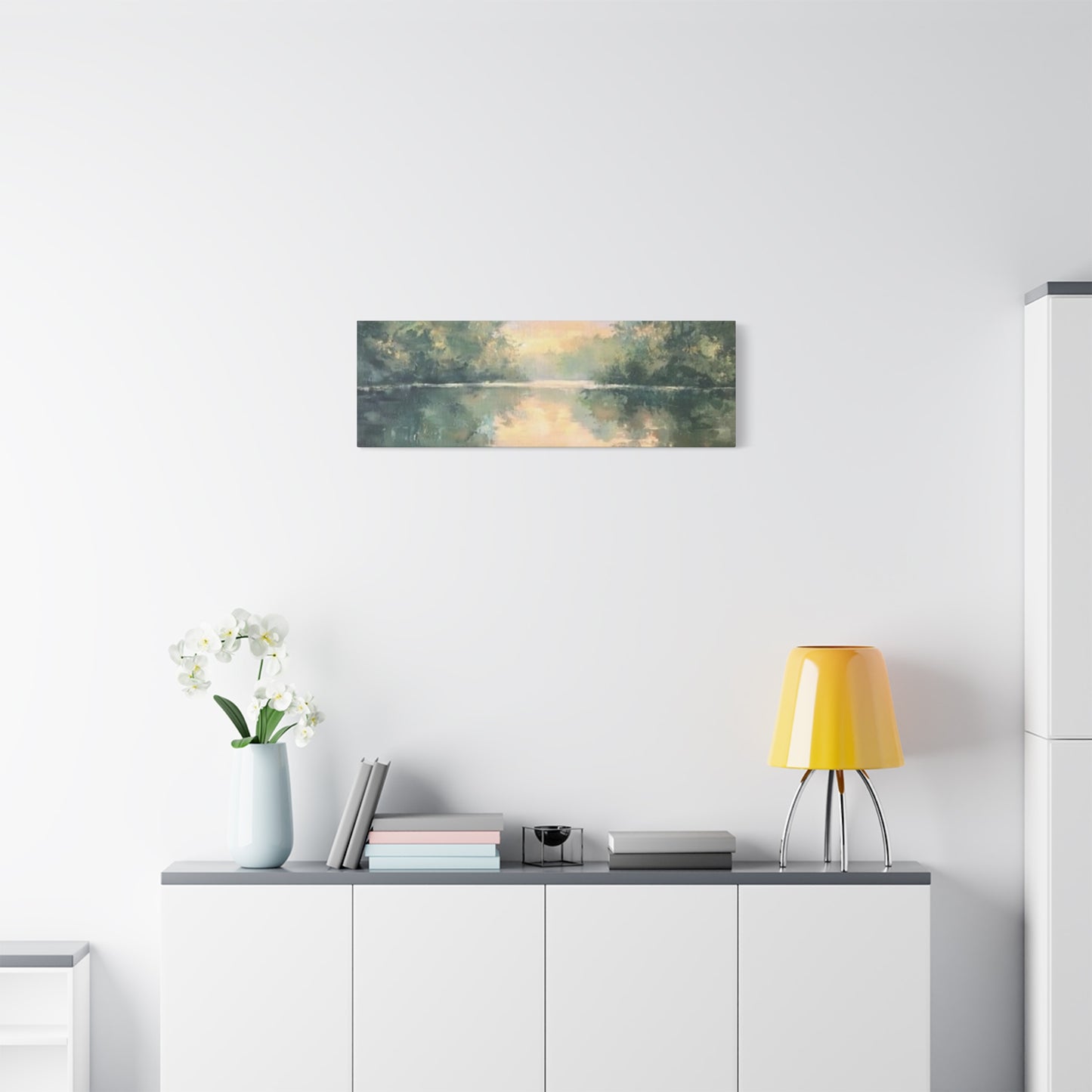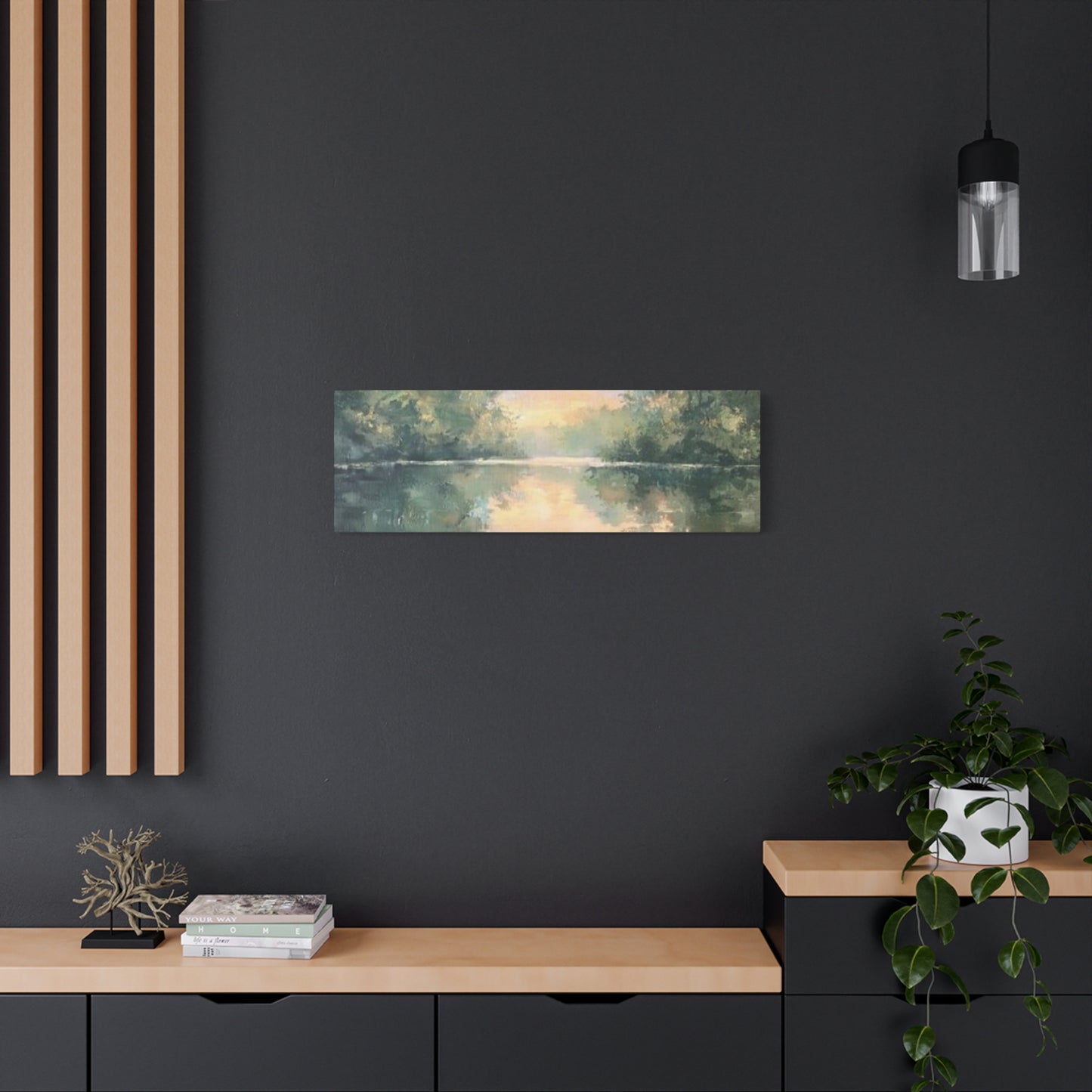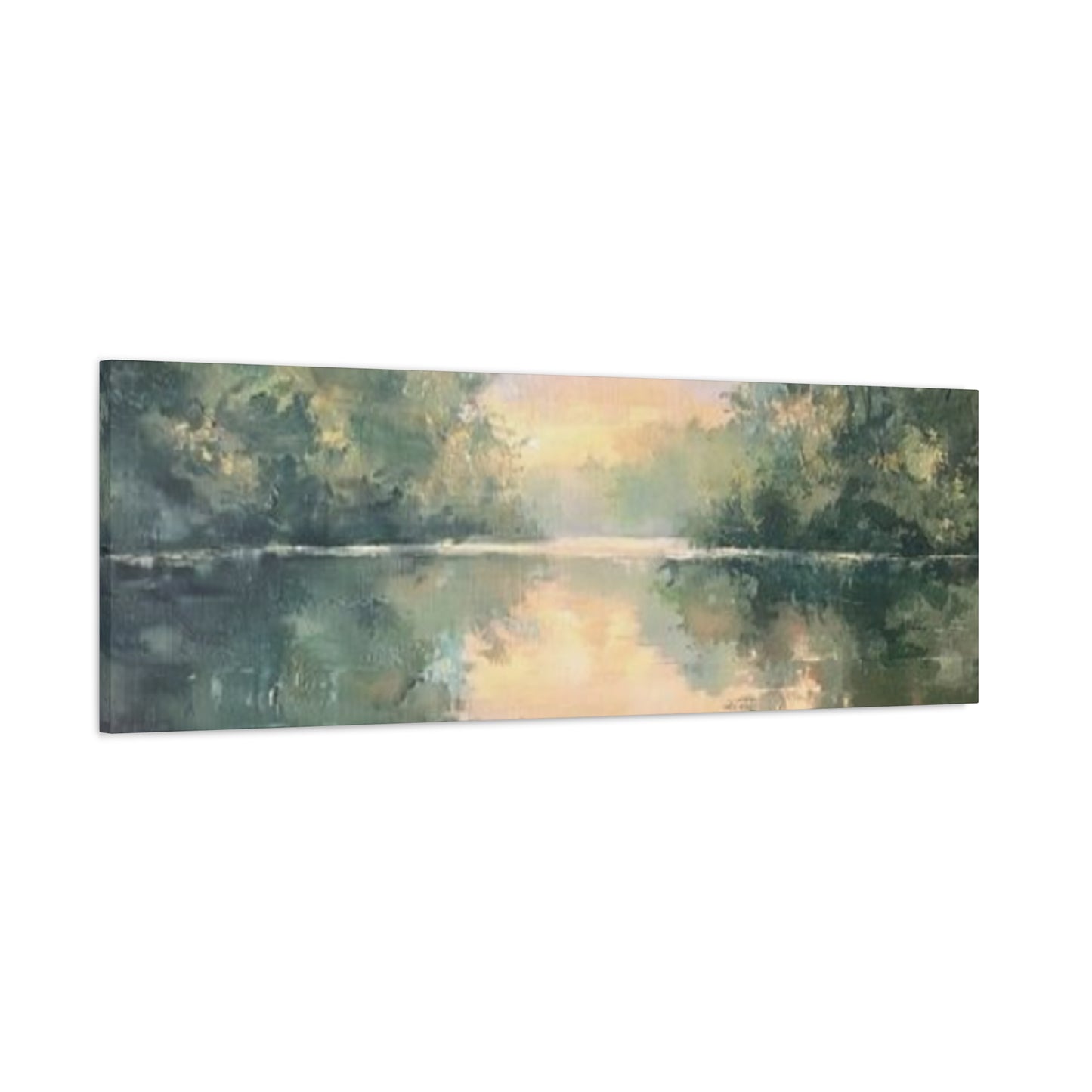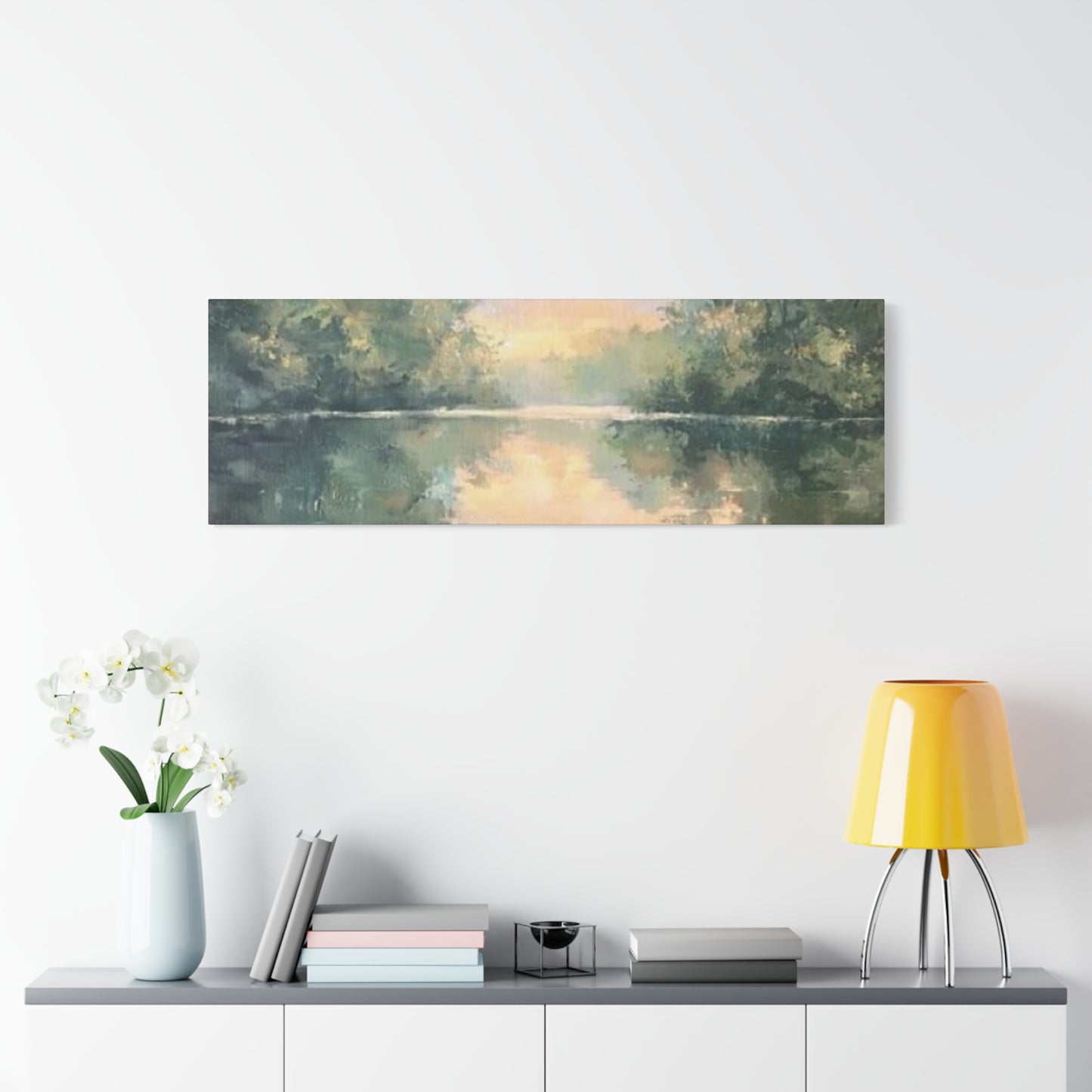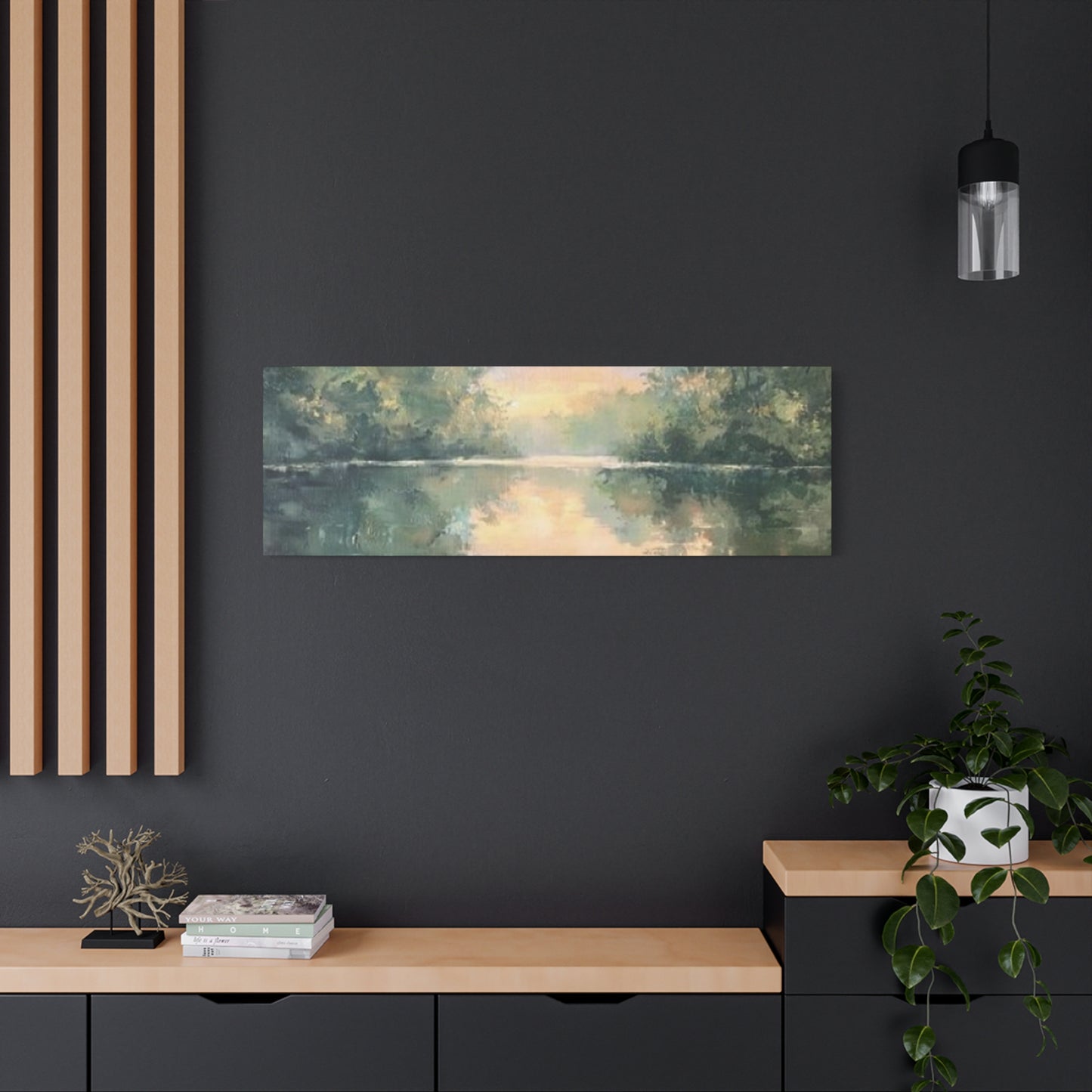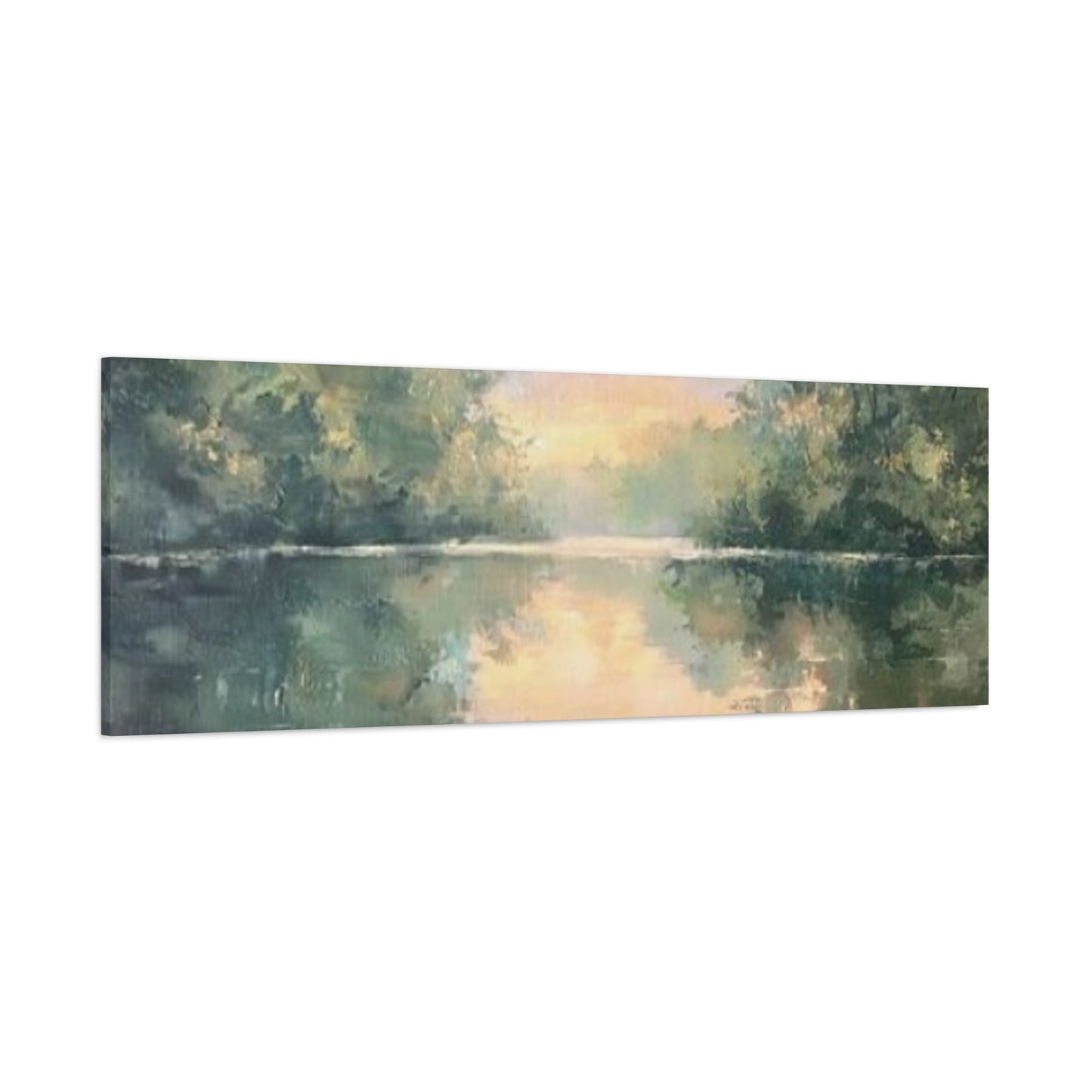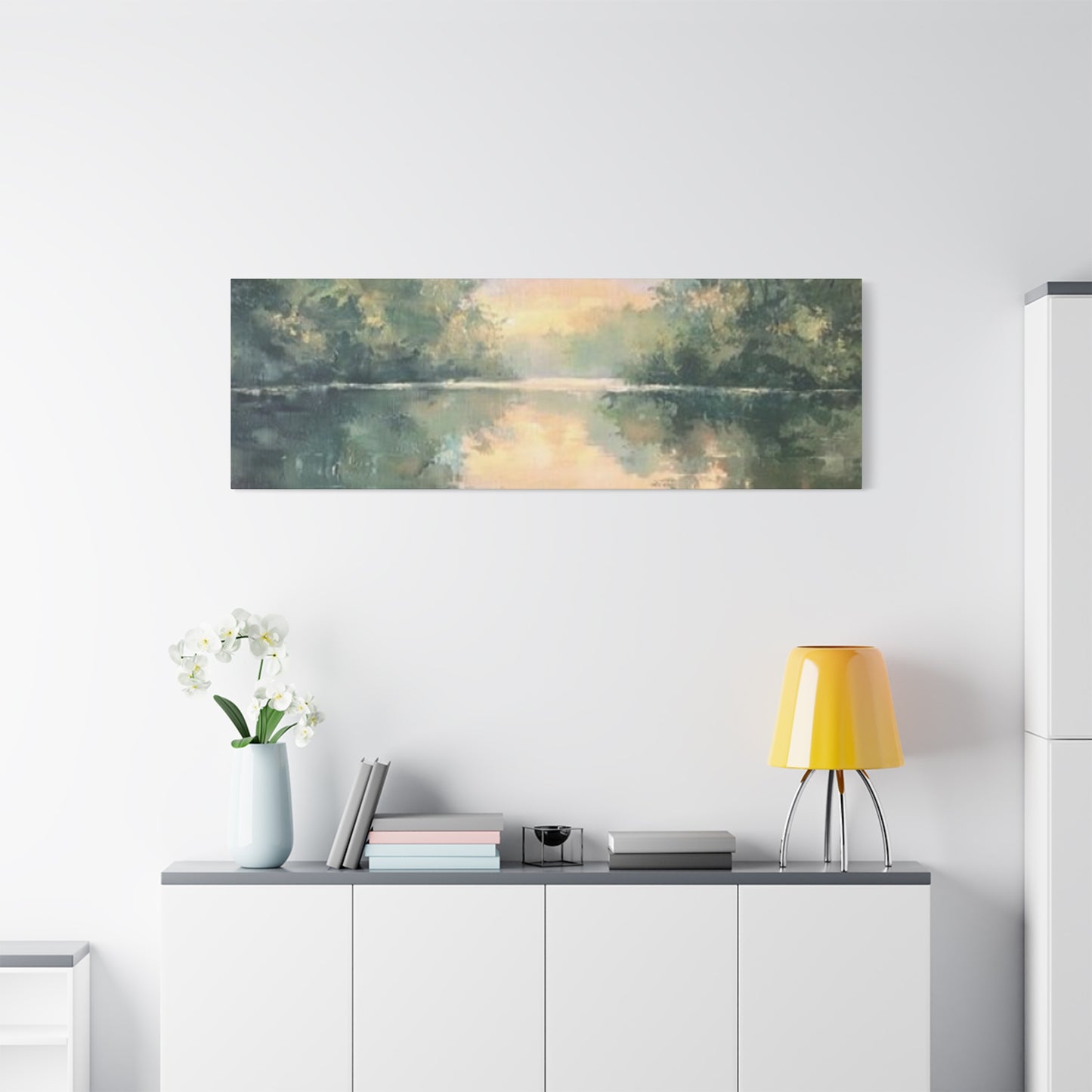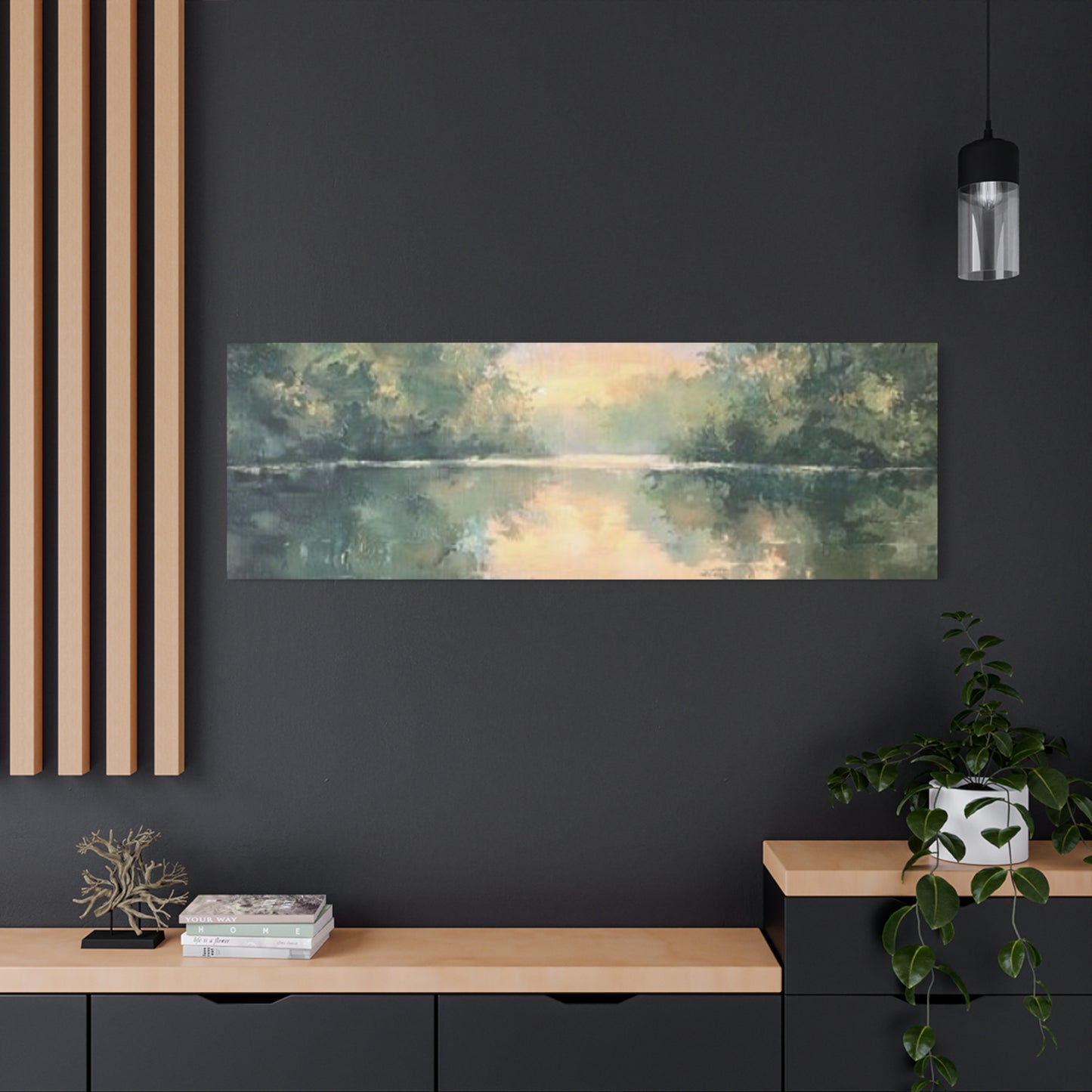Transform Your Home with Stunning River Mountain Panoramas Wall Art Canvas Prints
Natural landscape artwork has captivated human imagination for centuries, offering a window into the breathtaking beauty of untouched wilderness. River mountain panoramas wall art canvas prints represent the perfect fusion of artistic expression and natural wonder, bringing the serenity and majesty of pristine landscapes directly into your living environment. These magnificent pieces capture the essence of flowing waters meandering through dramatic mountain terrain, creating visual narratives that speak to our deepest connection with nature.
The appeal of landscape canvas prints extends far beyond mere decoration. They serve as daily reminders of the world's natural beauty, offering moments of tranquility and reflection in our increasingly busy lives. When you incorporate river mountain panoramas into your home, you're not simply hanging artwork – you're creating portals to peaceful outdoor sanctuaries that can instantly transform the mood and atmosphere of any room.
Canvas prints have revolutionized how we display photographic art, offering superior durability and visual impact compared to traditional paper prints. The texture of canvas adds depth and dimension to mountain and river imagery, enhancing the natural contours of landscapes and creating an almost tactile quality that draws viewers into the scene. This medium particularly excels at capturing the subtle gradations of light and shadow that make mountain panoramas so compelling.
The psychological benefits of incorporating natural imagery into living environments have been extensively documented by researchers and environmental psychologists. Studies consistently demonstrate that exposure to nature imagery can reduce stress levels, improve concentration, and promote overall well-being. River mountain panoramas wall art canvas prints tap into these benefits, offering a form of visual therapy that works continuously in your daily environment.
Contemporary printing technology has reached unprecedented levels of quality, allowing photographers and artists to reproduce their mountain and river imagery with stunning fidelity. High-resolution digital printing processes capture every nuance of color and detail, from the sparkling surface of mountain streams to the subtle atmospheric effects that occur when sunlight filters through mountain mist. This technological advancement ensures that canvas prints can faithfully reproduce the emotional impact of actually standing beside a mountain river.
The versatility of river mountain panoramas makes them suitable for virtually any decorative scheme. Whether your preference leans toward rustic cabin aesthetics, modern minimalism, or traditional elegance, these natural landscape prints can be seamlessly integrated into your existing décor. The organic shapes and earth-toned color palettes found in mountain river imagery complement both warm and cool color schemes, making them adaptable to various design preferences.
Collecting landscape canvas prints has become increasingly popular among art enthusiasts who appreciate both the aesthetic and investment potential of high-quality photographic art. River mountain panoramas, in particular, represent subjects that maintain enduring appeal across different generations and cultural backgrounds. The universal human attraction to water and mountains ensures that these pieces retain their relevance and desirability over time.
Professional photographers who specialize in landscape imagery often spend years perfecting their craft, traveling to remote locations and waiting for optimal lighting conditions to capture truly exceptional mountain river scenes. When you invest in quality canvas prints of their work, you're not only acquiring beautiful artwork but also supporting the artistic documentation of our planet's most precious natural environments.
The environmental consciousness that characterizes modern society has increased appreciation for artwork that celebrates natural beauty. River mountain panoramas wall art canvas prints align perfectly with this cultural shift, offering a way to bring nature indoors without compromising environmental principles. Many contemporary canvas printing processes utilize eco-friendly inks and sustainable materials, allowing environmentally conscious consumers to enjoy natural landscape art with clear consciences.
Selecting the Perfect River Mountain Canvas Print for Your Home
Choosing the ideal river mountain panorama for your living environment requires careful consideration of multiple factors that will influence both the visual impact and long-term satisfaction with your purchase. The selection process should begin with a thorough assessment of your available wall area, taking precise measurements to ensure optimal proportions between the artwork and surrounding architectural elements. Proper sizing is crucial for achieving the desired visual impact – too small, and the print may appear insignificant; too large, and it might overwhelm the room's other design elements.
Color harmony plays a fundamental role in successful art selection, particularly when incorporating natural landscape imagery into existing decorative schemes. River mountain panoramas typically feature earth-toned palettes dominated by blues, greens, grays, and browns, but subtle variations in these color families can significantly impact how the artwork interacts with your room's existing colors. Consider photographing your intended installation area under different lighting conditions to better evaluate how various color palettes might appear throughout the day.
The style and composition of river mountain imagery varies considerably among different artists and photographers, ranging from wide panoramic vistas that emphasize the grand scale of mountain landscapes to more intimate compositions that focus on specific details like cascading waterfalls or reflective pools. Panoramic formats work exceptionally well above sofas, beds, or dining tables, creating horizontal lines that complement furniture arrangements while drawing the eye across the entire composition.
Vertical compositions featuring dramatic mountain peaks rising above meandering rivers can create powerful focal points in rooms with high ceilings, while square formats offer versatility for grouping multiple pieces together. Consider how the composition's lines and movement will interact with your room's architectural features – flowing river lines can soften angular furniture edges, while jagged mountain silhouettes can add dynamic energy to otherwise static arrangements.
Lighting conditions in your intended display area significantly influence how canvas prints will appear throughout different times of day. Natural light from windows can enhance the luminosity of river and sky elements in landscape prints, but direct sunlight should be avoided to prevent color fading over time. Artificial lighting options, including track lighting, picture lights, and strategically placed lamps, can be used to highlight specific areas of the artwork and create dramatic effects that change throughout the day.
The emotional resonance of different mountain river scenes varies considerably based on factors like weather conditions, seasonal timing, and overall mood conveyed by the imagery. Sunrise and sunset scenes tend to create warm, optimistic feelings, while misty, overcast conditions can evoke more contemplative or mysterious moods. Consider the emotional atmosphere you want to establish in each room when selecting specific imagery – energizing scenes work well in kitchens and home offices, while more serene compositions suit bedrooms and meditation areas.
Quality considerations extend beyond the visual appeal of the image itself to include factors like canvas weight, stretching techniques, and frame construction. Premium canvas materials offer superior durability and color retention, while proper stretching ensures the print will maintain its shape and tension over time. Gallery-wrapped edges, where the image extends around the sides of the frame, create a more finished appearance and eliminate the need for additional framing.
Budget considerations should encompass not only the initial purchase price but also long-term value and potential appreciation. Limited edition prints by renowned landscape photographers often command higher prices initially but may increase in value over time, making them sound investments for serious collectors. Open edition prints offer more affordable options while still providing high-quality artwork for everyday enjoyment.
Authentication and provenance become important factors when investing in higher-priced landscape photography prints. Reputable artists and galleries provide certificates of authenticity, edition information, and artist signatures or stamps that verify the print's legitimacy and help establish its potential future value. Research the photographer's reputation, exhibition history, and market presence to make informed purchasing decisions.
Canvas Print Technology and Quality Standards
Modern canvas printing technology represents a remarkable convergence of traditional artistic techniques and cutting-edge digital innovation, producing results that rival and often exceed the quality of conventional photographic printing methods. The foundation of superior canvas prints lies in the sophisticated inkjet printing systems that utilize multiple color cartridges to achieve extraordinary color accuracy and tonal range. These advanced printers can reproduce millions of distinct colors, ensuring that the subtle gradations found in mountain mist, flowing water, and atmospheric lighting effects are faithfully captured in the final print.
The canvas substrate itself plays a crucial role in determining the final quality and longevity of landscape prints. Premium canvas materials are typically composed of cotton or cotton-polyester blends that provide optimal ink absorption while maintaining dimensional stability over time. The weave structure of the canvas affects how light interacts with the printed surface, with finer weaves producing smoother tonal transitions and coarser weaves adding textural interest that can enhance the perceived depth of mountain and river imagery.
Ink quality represents another critical factor in producing archival-quality canvas prints that will maintain their visual impact for decades. Pigment-based inks offer superior lightfastness and color stability compared to dye-based alternatives, ensuring that your river mountain panoramas will retain their original vibrancy even when displayed in areas with significant ambient light. The molecular structure of pigment inks allows them to form more stable bonds with canvas fibers, reducing the likelihood of color migration or fading over time.
Color management throughout the printing process requires sophisticated software and hardware calibration to ensure accurate color reproduction from digital file to final print. Professional printing facilities utilize color-calibrated monitors, standardized lighting conditions, and regular printer profiling to maintain consistent results across different print runs. This attention to color accuracy is particularly important for landscape imagery, where subtle color variations can dramatically impact the overall mood and realism of the scene.
Resolution requirements for canvas printing differ significantly from those needed for standard paper prints, as the textured surface of canvas can effectively mask certain digital artifacts while requiring higher resolution to maintain sharp detail in fine elements like water ripples or distant mountain features. Professional landscape photographers typically capture their images at extremely high resolutions using medium format or full-frame digital cameras, ensuring that even large-format canvas prints maintain exceptional detail and clarity.
Pre-press preparation involves sophisticated image processing techniques designed to optimize digital files for canvas printing. This process may include selective sharpening to compensate for the canvas texture, color space conversion to match the printer's capabilities, and careful adjustment of shadow and highlight details to ensure optimal reproduction across the full tonal range. Skilled technicians use professional software to make these adjustments while preserving the artistic intent of the original photographer.
Quality control measures implemented by reputable canvas printing facilities include multiple checkpoints throughout the production process, from initial file assessment through final inspection before shipping. Color accuracy is verified using calibrated viewing booths that simulate various lighting conditions, while print quality is evaluated under magnification to detect any potential defects or inconsistencies. These rigorous standards ensure that each river mountain panorama canvas print meets professional gallery standards.
Stretching and mounting techniques significantly impact both the appearance and longevity of canvas prints. Museum-quality stretching utilizes acid-free wooden frames and archival mounting hardware that won't react with the canvas or inks over time. Proper tension distribution prevents sagging or warping while maintaining the canvas's structural integrity. Gallery wrap techniques, where the image extends around the edges of the frame, create a contemporary presentation that eliminates the need for additional framing while ensuring the image remains the focal point.
Protective coatings applied to finished canvas prints provide an additional layer of defense against environmental factors that could potentially damage the artwork over time. These transparent coatings can offer UV protection, moisture resistance, and easier cleaning maintenance while maintaining the natural texture and appearance of the canvas surface. Some coatings also provide anti-fade properties that extend the effective lifespan of the printed colors.
Mountain Photography Techniques and Artistic Vision
Professional mountain landscape photography demands a unique combination of technical expertise, artistic vision, and physical endurance that sets it apart from most other photographic disciplines. Capturing the dramatic interplay between mountain terrain and flowing water requires photographers to master complex lighting conditions, extreme weather challenges, and the logistical difficulties of accessing remote locations where the most spectacular river mountain panoramas occur naturally.
The technical challenges of mountain photography begin with camera equipment selection and preparation for harsh environmental conditions. Professional landscape photographers typically utilize full-frame or medium-format digital cameras capable of capturing maximum detail and dynamic range in challenging lighting situations. Weather sealing becomes essential when working around mountain rivers, where spray, humidity, and sudden weather changes can threaten sensitive electronic equipment. Lens selection often favors wide-angle options for capturing expansive panoramic vistas, while telephoto lenses allow photographers to isolate specific compositional elements and compress distant mountain ranges.
Timing represents perhaps the most critical factor in capturing exceptional mountain river imagery, as lighting conditions can transform ordinary scenes into extraordinary artistic statements within minutes. The golden hours surrounding sunrise and sunset provide warm, directional light that enhances mountain textures and creates dramatic shadows that define three-dimensional form. Alpine glow, a phenomenon where mountain peaks reflect warm light even after the sun has set, can produce ethereal effects that seem almost supernatural in their beauty.
Weather patterns in mountain environments create constantly changing photographic opportunities, with dramatic storm systems, clearing skies, and atmospheric effects providing dynamic backdrops for river valley compositions. Experienced mountain photographers learn to read weather signs and position themselves to capture the brief moments when clearing storms reveal snow-capped peaks through dramatic cloud formations. These challenging conditions often produce the most memorable and emotionally compelling imagery.
Compositional techniques specific to mountain river photography involve careful consideration of how linear elements guide the viewer's eye through the frame. Rivers naturally create leading lines that draw attention into the composition, while their meandering paths can create visual rhythms that add movement and energy to otherwise static landscape scenes. The relationship between foreground water elements and distant mountain peaks requires careful attention to depth of field and focus stacking techniques to ensure sharp detail throughout the entire composition.
Seasonal variations dramatically impact both the accessibility and visual character of mountain river locations. Spring snowmelt creates powerful waterfalls and rushing streams that add dynamic energy to compositions, while autumn colors provide warm contrast against cool mountain stone and evergreen forests. Winter photography presents extreme challenges but rewards dedicated photographers with pristine snow-covered landscapes and ice formations that create unique textural elements.
The artistic vision required for exceptional mountain river photography extends beyond technical proficiency to encompass emotional interpretation and personal expression. Successful landscape photographers develop distinctive styles that reflect their individual perspectives on natural beauty, whether favoring dramatic, high-contrast interpretations or subtle, minimalist approaches that emphasize serenity and contemplation. This personal vision becomes the distinguishing factor that separates truly memorable artwork from merely technically competent documentation.
Long-term commitment to specific mountain regions allows photographers to develop intimate knowledge of seasonal patterns, weather tendencies, and optimal timing for various locations. This familiarity enables them to anticipate and capture unique moments that casual visitors might never witness. Many renowned mountain photographers return to favorite locations repeatedly over many years, building comprehensive bodies of work that document the subtle changes and variations that occur in natural environments.
Conservation awareness has become an increasingly important aspect of mountain landscape photography, with many professionals viewing themselves as visual advocates for wilderness preservation. Their images serve not only as artistic expressions but also as documentation of natural environments that face increasing pressure from climate change and human development. This conservation ethic often influences both the locations photographers choose to document and how they present their work to the public.
Digital post-processing techniques specific to mountain river imagery require sophisticated understanding of how to enhance natural beauty without compromising authenticity. Professional photographers utilize advanced software to optimize dynamic range, enhance atmospheric effects, and fine-tune color relationships while maintaining the realistic character that makes landscape photography compelling. These processing skills, combined with exceptional field technique, enable the creation of canvas prints that faithfully convey the emotional impact of actually experiencing these magnificent natural environments.
Color Psychology and Mood Enhancement in Natural Landscapes
The psychological impact of color in natural landscape artwork operates on both conscious and subconscious levels, influencing mood, energy levels, and overall emotional well-being in ways that extend far beyond simple aesthetic appreciation. River mountain panoramas wall art canvas prints typically feature complex color palettes that mirror the natural world's sophisticated chromatic relationships, creating opportunities for profound psychological benefits when strategically incorporated into living environments.
Blue tones, which dominate most river and sky elements in mountain landscape imagery, possess well-documented calming and stabilizing psychological effects. Research in color psychology demonstrates that exposure to various shades of blue can lower blood pressure, reduce anxiety, and promote feelings of tranquility and peace. The specific blues found in mountain streams and alpine lakes carry associations with purity, clarity, and renewal that can be particularly beneficial in bedrooms, meditation areas, and other locations where relaxation and rest are priorities.
Green elements from forest vegetation and riverside plant life introduce psychological associations with growth, harmony, and natural balance. Different shades of green produce varying emotional responses – the vibrant greens of spring foliage energize and invigorate, while the deeper, more muted greens of evergreen forests provide stability and grounding. These psychological effects make river mountain panoramas featuring prominent green elements excellent choices for home offices, study areas, and other locations where concentration and mental clarity are important.
Earth tones from mountain stone, riverbank soil, and weathered rock formations contribute psychological qualities of stability, reliability, and connection to natural cycles. Browns, tans, and gray tones create feelings of security and permanence while providing neutral backgrounds that allow other colors to appear more vibrant by contrast. These earth tone elements make mountain river canvas prints particularly suitable for creating cozy, welcoming atmospheres in family rooms and gathering areas.
The interplay between warm and cool colors within mountain river scenes creates dynamic psychological effects that can energize or calm depending on which temperature dominates the composition. Sunrise and sunset scenes featuring warm golden and orange tones against cool mountain backgrounds create stimulating contrasts that can invigorate morning routines or provide inspiring evening reflections. Cooler compositions dominated by blues and grays promote contemplation and peaceful reflection.
Seasonal color variations in mountain river imagery offer opportunities to rotate artwork according to personal psychological needs and preferences. Spring scenes featuring fresh greens and clear blues can combat winter depression and seasonal affective disorder, while autumn compositions with warm oranges and reds can extend feelings of summer warmth into cooler months. This seasonal rotation strategy allows homeowners to actively manage their emotional environments through strategic art selection.
The saturation and intensity of colors within landscape canvas prints significantly impact their psychological effectiveness. Highly saturated colors create energizing, stimulating effects that work well in active areas like kitchens and exercise rooms, while more muted, desaturated palettes promote calm and relaxation in bedrooms and quiet retreats. Understanding these relationships allows for more intentional selection of artwork that supports specific lifestyle goals and emotional needs.
Light reflection and refraction effects in river water create constantly changing color relationships that add psychological complexity to mountain landscape compositions. The sparkle and movement suggested by these water effects can create feelings of vitality and renewal, while still water that perfectly reflects mountain peaks promotes feelings of balance and harmony. These subtle psychological cues operate below the threshold of conscious awareness but contribute significantly to the overall emotional impact of the artwork.
Color memory associations play crucial roles in how individuals respond to specific landscape color combinations. People who have positive memories of mountain vacations, camping trips, or outdoor adventures may find particular color palettes especially appealing and emotionally resonant. This personal connection can amplify the psychological benefits of river mountain panorama canvas prints, making them more than mere decoration and transforming them into triggers for positive emotional states.
Cultural and regional color associations also influence how mountain river imagery is perceived and appreciated. Different cultures assign varying symbolic meanings to natural colors, and these associations can enhance or modify the psychological impact of landscape artwork. Understanding these cultural dimensions can be particularly important when selecting artwork for diverse households or professional environments where multiple cultural perspectives are represented.
Therapeutic applications of color in landscape artwork have gained recognition among healthcare professionals and therapeutic practitioners who utilize environmental design to promote healing and well-being. River mountain panoramas with their complex, naturally balanced color relationships can provide ongoing color therapy benefits, supporting mental health and emotional stability through consistent exposure to psychologically beneficial chromatic combinations.
Room-by-Room Placement Strategies for Maximum Impact
Strategic placement of river mountain panoramas wall art canvas prints requires careful consideration of each room's specific function, lighting conditions, and existing design elements to maximize both visual impact and psychological benefits. The relationship between artwork placement and room usage patterns significantly influences how occupants experience and benefit from natural landscape imagery throughout their daily routines.
Living room placement strategies should prioritize creating focal points that encourage relaxation and social interaction while complementing the room's primary furniture arrangements. Large panoramic canvas prints work exceptionally well positioned above sofas or fireplace mantels, where their horizontal orientation mirrors the room's main seating areas and creates visual balance. The height should allow comfortable viewing from seated positions while ensuring the artwork doesn't overwhelm other design elements or architectural features.
Bedroom environments benefit from river mountain imagery that promotes tranquility and restful sleep, making placement decisions particularly important for psychological well-being. Positioning peaceful mountain river scenes where they're visible from the bed can provide calming focal points for morning awakening and evening relaxation routines. However, avoid placing dramatic or highly energizing compositions directly opposite the bed, as these might be too stimulating for optimal sleep preparation.
Kitchen and dining area placements should consider the room's social nature and meal preparation activities. River mountain panoramas can create pleasant conversation focal points during meals while providing visual relief from the functional elements that dominate most kitchen designs. Smaller format prints or series of related images work well in these areas, where wall space is often interrupted by cabinets, appliances, and windows.
Home office and study area placements require careful balance between inspirational impact and potential distraction. Mountain river scenes can provide beneficial breaks for the eyes during computer work and contribute to stress reduction during challenging tasks. However, placement should ensure the artwork enhances rather than competes with work-related activities. Side wall positions often work better than direct sight lines from primary work areas.
Bathroom environments present unique opportunities and challenges for canvas print placement due to humidity concerns and limited wall space. When properly protected with appropriate sealers and placed away from direct water exposure, river mountain panoramas can transform utilitarian bathroom spaces into spa-like retreats. The association between mountain streams and cleansing rituals can enhance the psychological benefits of daily personal care routines.
Hallway and transitional area placements can create visual journeys that connect different living spaces while providing opportunities to display multiple related pieces. Long horizontal panoramas work particularly well in hallways, creating the sensation of windows opening onto mountain vistas. These transitional placements can help establish consistent design themes throughout the home while making efficient use of otherwise underutilized wall areas.
Stairway placements require special attention to viewing angles and safety considerations, as artwork will be seen from various perspectives as people move up and down the stairs. Vertical compositions often work better than horizontal formats in these locations, and installation height should ensure visibility from multiple levels while maintaining appropriate clearance for safe passage.
Lighting integration strategies significantly impact how canvas prints appear throughout different times of day and under various artificial lighting conditions. Natural light from windows can enhance the luminous qualities of river water and sky elements, but direct sunlight should be avoided to prevent color fading. Artificial lighting options, including picture lights, track lighting, and strategically placed lamps, can create dramatic effects that transform the artwork's appearance between day and night.
Scale relationships between artwork and surrounding furniture require careful consideration to achieve balanced, harmonious arrangements. The general rule suggests artwork should occupy approximately two-thirds to three-quarters the width of furniture pieces placed below it, but this guideline can be modified based on ceiling height, room size, and personal preferences. Multiple smaller pieces can be grouped to achieve the visual weight of single large pieces while providing more flexibility in arrangement options.
Seasonal rotation strategies allow homeowners to modify their environments according to changing preferences, psychological needs, or decorative themes. This approach works particularly well with river mountain imagery, where seasonal variations in the same locations can provide different moods and color palettes. Storage and rotation systems should protect artwork while allowing easy access for periodic changes.
Traffic flow considerations ensure that artwork placement enhances rather than impedes natural movement patterns through rooms. Prime viewing locations should be accessible and comfortable, allowing occupants to appreciate the artwork without awkward positioning or strained viewing angles. Consider how people naturally move through and use each room when determining optimal placement positions for maximum enjoyment and psychological benefit.
Decorative Styles and Complementary Design Elements
River mountain panoramas wall art canvas prints demonstrate remarkable versatility in complementing various decorative styles, from rustic cabin aesthetics to contemporary minimalist approaches. The natural subject matter and earth-toned color palettes inherent in mountain river imagery provide flexible design elements that can be successfully integrated into diverse home décor schemes while maintaining their artistic integrity and emotional impact.
Rustic and cabin-style décor environments provide natural settings for mountain river canvas prints, where the artwork's subject matter directly reinforces the overall design theme. In these settings, the prints can be paired with natural wood furniture, stone fireplace surrounds, and textural elements like woven blankets and leather upholstery. The key lies in selecting prints with appropriate color temperatures and compositional styles that enhance rather than compete with the room's existing natural materials and textures.
Contemporary and modern design approaches require more careful consideration of how traditional landscape imagery integrates with clean lines, minimalist compositions, and sophisticated color schemes. Large-format panoramic prints with simplified compositions and subtle color palettes work particularly well in contemporary settings, where they can serve as dramatic focal points while maintaining the visual clarity that characterizes modern design. Frameless gallery-wrapped presentations enhance the contemporary aesthetic by eliminating traditional framing elements.
Traditional and classic décor styles can successfully incorporate river mountain panoramas through careful attention to proportions, color coordination, and complementary accessories. In these settings, the prints might be paired with antique furniture pieces, oriental rugs, and classic lighting fixtures. The timeless appeal of natural landscape imagery ensures compatibility with traditional design elements, while the canvas format provides contemporary presentation that bridges different style periods.
Transitional style environments, which blend traditional and contemporary elements, provide ideal settings for mountain river canvas prints that can serve as unifying design elements. The natural subject matter appeals to traditional sensibilities while the modern printing and presentation techniques satisfy contemporary aesthetic preferences. This style flexibility makes river mountain panoramas particularly valuable for homeowners who prefer eclectic design approaches.
Industrial design themes might seem challenging for natural landscape integration, but carefully selected mountain river prints can provide essential softening elements that humanize stark industrial aesthetics. The key lies in choosing prints with stronger contrast, more dramatic lighting, and compositions that echo the bold, uncompromising character of industrial design while introducing natural elements that create psychological balance.
Scandinavian and Nordic design philosophies, with their emphasis on natural materials, muted color palettes, and connection to outdoor environments, provide excellent contexts for river mountain canvas prints. The clean, simplified presentations typical of Scandinavian style complement the organic forms and natural color relationships found in mountain river imagery. Light wood tones and neutral textiles commonly used in Nordic décor schemes harmonize beautifully with the earth tones present in mountain landscapes.
Mediterranean and coastal design themes can successfully incorporate mountain river prints through careful color coordination and thematic connections to natural environments. While the imagery might not directly reference coastal environments, the connection to natural water elements creates thematic bridges that allow mountain river scenes to complement Mediterranean color palettes dominated by blues, whites, and earth tones.
Complementary furniture selection plays crucial roles in maximizing the impact of river mountain panorama canvas prints. Natural wood furniture with visible grain patterns can echo the organic textures suggested in mountain forest imagery, while leather upholstery provides textural contrast that enhances the visual complexity of the overall design scheme. Metal accents can reference the mineral elements present in mountain stone formations, creating subtle thematic connections throughout the room.
Textile coordination involves selecting fabrics, patterns, and textures that enhance rather than compete with the canvas prints' visual elements. Solid colors drawn from the artwork's palette can create harmonious color schemes, while natural textures like wool, linen, and cotton can reinforce the organic character of mountain river imagery. Pattern selection should be approached carefully, with preference given to organic or geometric designs that complement rather than conflict with the natural forms depicted in the prints.
Lighting fixture selection provides opportunities to reinforce the natural themes established by river mountain canvas prints while providing appropriate illumination for optimal artwork viewing. Natural materials like wood, stone, and metal can create fixtures that complement the outdoor themes, while adjustable lighting systems allow for modification of the artwork's appearance throughout different times of day.
Accessory coordination allows for subtle reinforcement of mountain river themes without creating overly literal or kitschy design schemes. Natural materials like river stones, weathered wood pieces, and mineral specimens can provide textural interest while maintaining thematic connections to the canvas prints. However, restraint is important to avoid overwhelming the space with too many nature-themed elements that might diminish the artwork's impact through redundancy.
Seasonal Decoration and Artwork Rotation Systems
Implementing seasonal rotation systems for river mountain panoramas wall art canvas prints provides dynamic opportunities to maintain visual interest while responding to changing psychological needs throughout the year. This approach treats artwork as an active component of home décor rather than static decoration, allowing homeowners to optimize their living environments according to seasonal preferences, lighting changes, and emotional requirements.
Spring rotation strategies focus on selecting mountain river imagery that captures the renewal and awakening associated with this season of growth and transformation. Prints featuring rushing snowmelt streams, emerging vegetation, and clear, bright skies can help combat winter lethargy while celebrating the natural world's annual rebirth. The psychological benefits of spring imagery include increased energy levels, optimism, and motivation, making these selections particularly valuable for areas where morning routines and daily planning activities occur.
Summer rotations emphasize mountain river scenes that provide psychological cooling and escape from hot weather conditions. Images featuring deep forest shade, cool mountain streams, and misty morning conditions can create psychological relief during warm months while maintaining visual connections to refreshing outdoor environments. The calming blue and green tones prevalent in summer mountain river scenes contribute to feelings of coolness and relaxation that complement warm weather lifestyle preferences.
Autumn selections celebrate the dramatic color transformations that occur in mountain environments during fall months, providing opportunities to introduce warm orange, red, and gold tones that complement seasonal decorating themes while maintaining the natural character that makes mountain river imagery appealing year-round. These warmer color palettes can help extend psychological summer warmth into cooler months while preparing for winter's more subdued palette preferences.
Winter rotations often favor mountain river scenes that emphasize the stark beauty and serene qualities of snow-covered landscapes. These images can provide psychological warmth through their suggestion of pristine natural environments while offering visual variety during months when outdoor activities may be limited by weather conditions. The monochromatic qualities of winter mountain scenes work particularly well with holiday decorating themes and winter color palettes.
Storage solutions for seasonal artwork rotation require careful attention to preservation and organization to ensure canvas prints remain in excellent condition during periods when they're not displayed. Acid-free storage materials, climate-controlled environments, and protective wrapping prevent damage while maintaining accessibility for easy rotation. Proper labeling and organization systems facilitate efficient seasonal transitions without confusion or handling damage.
Rotation scheduling can be based on traditional seasonal divisions, personal preferences, or specific psychological needs that arise throughout the year. Some homeowners prefer quarterly rotations that align with calendar seasons, while others might rotate monthly or even more frequently to maintain maximum visual interest. The key lies in establishing systems that provide variety without becoming burdensome or expensive to maintain.
Installation hardware systems designed for easy artwork changes can significantly simplify rotation processes while protecting walls from repeated installation damage. Professional picture hanging systems with adjustable hooks and wire systems allow for quick artwork changes without tools or wall modifications. These systems are particularly valuable for homeowners who enjoy frequent decoration changes or want to experiment with different placement options.
Psychological benefits of seasonal rotation extend beyond simple visual variety to include active engagement with environmental changes and natural cycles. The process of selecting and installing seasonal artwork can become a mindful practice that enhances awareness of natural rhythms while providing opportunities for creative expression and environmental control. This active participation in decoration can contribute to feelings of empowerment and connection to natural cycles.
Budget considerations for rotation systems can be managed through strategic purchasing of complementary pieces over time, creating rotation collections that grow gradually rather than requiring large initial investments. Limited edition prints and seasonal sales provide opportunities to build rotation collections economically while ensuring quality and long-term value. Planning purchases around seasonal transitions can also help spread costs throughout the year.
Coordination with other seasonal decorating elements allows artwork rotation to integrate seamlessly with broader seasonal decoration strategies. Color palettes, textural elements, and thematic accessories can be coordinated with rotating artwork to create comprehensive seasonal transformations that maximize psychological and aesthetic benefits. This integrated approach ensures that artwork changes support rather than conflict with other seasonal decoration efforts.
Documentation and tracking systems help homeowners maintain organization and planning for seasonal rotations while building understanding of which combinations work most effectively in different rooms and seasons. Photography of successful arrangements, notation of preferred seasonal combinations, and tracking of rotation schedules can inform future decisions while building expertise in personal seasonal decoration preferences.
Gallery Wall Creation and Multi-Piece Arrangements
Creating compelling gallery walls with river mountain panoramas wall art canvas prints requires sophisticated understanding of visual relationships, proportional balance, and compositional flow that transforms individual artworks into cohesive environmental statements. Multi-piece arrangements offer opportunities to tell visual stories, create dramatic focal points, and establish thematic connections that single pieces cannot achieve while maximizing the decorative impact of mountain river imagery.
Planning gallery wall layouts begins with careful measurement and template creation that allows for experimentation with different arrangements before committing to wall installation. Paper templates cut to match actual artwork dimensions can be arranged and rearranged on floors or temporarily attached to walls using removable tape, enabling visualization of various configuration options without damaging walls or artwork. This planning phase should consider not only the relationships between individual pieces but also their interaction with surrounding architectural elements and furniture placement.
Scale variation within gallery arrangements creates visual interest and hierarchical emphasis that guides viewer attention while maintaining overall compositional balance. Combining large panoramic mountain river prints with smaller detail-focused pieces allows for both dramatic impact and intimate examination of specific natural elements. The largest piece typically serves as the arrangement's anchor, with smaller pieces supporting and elaborating on its themes while contributing to overall visual flow.
Color coordination throughout multi-piece arrangements requires careful attention to how different mountain river scenes work together to create harmonious or intentionally contrasting color relationships. Pieces sharing similar color palettes create serene, unified effects, while strategic color contrasts can add energy and visual excitement. The key lies in ensuring that color relationships enhance rather than compete, creating overall effects that are greater than the sum of individual pieces.
Compositional flow considerations guide how viewers' eyes move through gallery arrangements, with successful layouts creating visual pathways that encourage exploration and discovery. Linear elements within individual mountain river prints, such as riverbanks, shorelines, and mountain ridgelines, can be arranged to create implied connections between pieces that unify the overall arrangement while maintaining each print's individual integrity.
Spacing and proportion relationships significantly impact how gallery walls appear and function within their architectural contexts. Generally, pieces should be spaced closely enough to read as unified arrangements rather than separate decorations, with spacing distances typically ranging from two to six inches depending on the pieces' sizes and the overall arrangement's scale. Consistent spacing creates formal, organized effects, while varied spacing can add organic, natural qualities that complement mountain river imagery.
Thematic organization strategies allow for gallery walls that tell visual stories or explore specific aspects of mountain river environments in depth. Arrangements might progress from wide landscape vistas to intimate water detail shots, creating visual journeys that mirror actual hiking experiences. Seasonal progressions, showing the same locations under different conditions, can create time-based narratives that demonstrate natural environments' dynamic character.
Installation techniques for multi-piece arrangements require careful attention to leveling, alignment, and secure mounting to ensure professional appearances that enhance rather than detract from the artwork's impact. Professional installation hardware appropriate for canvas weights and wall types prevents sagging or shifting over time while ensuring viewer safety. Consider hiring professional installers for large or complex arrangements to ensure optimal results.
Lighting strategies for gallery walls must address the varying lighting needs of different pieces while creating overall illumination that enhances the arrangement's unity and impact. Track lighting systems with adjustable fixtures allow for individualized lighting of specific pieces while maintaining overall illumination balance. Avoiding reflective glare while ensuring adequate illumination requires careful fixture positioning and lamp selection.
Maintenance considerations for multi-piece arrangements include regular cleaning protocols, periodic condition assessments, and potential rearrangement opportunities as collections grow or preferences change. Establishing routine inspection schedules helps identify potential issues before they become serious problems while maintaining the arrangement's optimal appearance over time.
Growth planning allows gallery walls to evolve organically as new pieces are acquired or preferences change over time. Initial arrangements can be designed with expansion possibilities in mind, leaving room for additional pieces or reconfiguration as collections develop. This approach treats gallery walls as living, growing design elements rather than fixed installations.
Documentation of successful arrangements through photography helps preserve arrangement ideas for future reference while building a personal library of effective design solutions. This documentation becomes particularly valuable when rearranging pieces or planning new gallery walls in different locations, providing tested configuration options that can be adapted to new architectural contexts.
Conclusion
Stunning river mountain panoramas wall art canvas prints offer a transformative way to bring the majesty of nature into your home. These breathtaking scenes—where flowing rivers wind through towering mountains beneath expansive skies—capture the raw beauty of the natural world in a way that is both grounding and inspiring. More than just art, these prints become windows to faraway landscapes, evoking a sense of peace, freedom, and awe with every glance.
The powerful combination of rivers and mountains in panoramic compositions taps into two timeless symbols: the flowing river as a metaphor for life’s journey, and the steadfast mountain as a symbol of strength and permanence. When presented on a high-quality canvas, these themes are brought to life with vivid color, stunning detail, and a sense of immersive depth that draws the viewer in.
Whether you’re decorating a cozy cabin, a contemporary apartment, or a spacious open-concept home, river mountain panoramas offer unmatched versatility. Their wide, sweeping format naturally complements large walls, creating a dramatic focal point in living rooms, hallways, bedrooms, or offices. Paired with minimalist furnishings or earthy décor elements like wood, stone, or natural textiles, they seamlessly enhance the overall aesthetic of the space.
Beyond visual appeal, these artworks contribute to emotional wellness. The tranquil river scenes soothe the mind, while the grandeur of mountain ranges inspires perspective and calm. In a world that often feels fast and cluttered, surrounding yourself with images of nature’s vast, quiet beauty is a subtle yet powerful way to restore balance and serenity in your living environment.
In conclusion, transforming your home with stunning river mountain panorama canvas prints allows you to experience the peace, majesty, and emotional richness of the outdoors every day. It’s a timeless choice that uplifts your décor, nourishes your spirit, and brings the grandeur of the natural world into your personal sanctuary.













